The views expressed in this post are those of the author and not necessarily those of Open Nuclear Network or any other agency, institution or partner.
Since December 2021, new developments have been observed at the Punggye-ri nuclear test site of the Democratic People's Republic of Korea (DPRK), showing that the DPRK has reactivated, or is in the process of reactivating, some parts of this nuclear weapon test site. This includes probable restoration of one of the four former test tunnels, specifically, the one that had been built but not previously used for testing.
This brief offers observations on these developments based on available open-source information.
Summary of Findings
The satellite imagery available to ONN shows new developments at the Punggye-ri nuclear test site of the Democratic People's Republic of Korea (DPRK) since December 2021, including signs of excavation of one of the four former test tunnels, nearby construction and renovation activities and signs of increased vehicle traffic and movement of personnel near that tunnel.
These developments clearly indicate that the DPRK has reactivated, or is in the process of reactivating, some parts of its nuclear weapon test site, especially the locations known as the main administrative area and the South Portal within this site. This activity is noteworthy as the DPRK ended its moratorium on testing intercontinental-range ballistic missiles (ICBMs) in March 2022. It is assessed as likely that the DPRK may also end its moratorium on nuclear weapon testing in the near future.
Background
The DPRK's nuclear weapon test site is located at Punggye-ri in the North Hamgyong Province. At this site, four tunnels were constructed at different points of time between 2006 and May 2018 for the purpose of nuclear weapon tests. The entrances to Tunnels 1, 2, 3 and 4 are referred to the East, North, South, and West Portals, respectively (Figure 1).
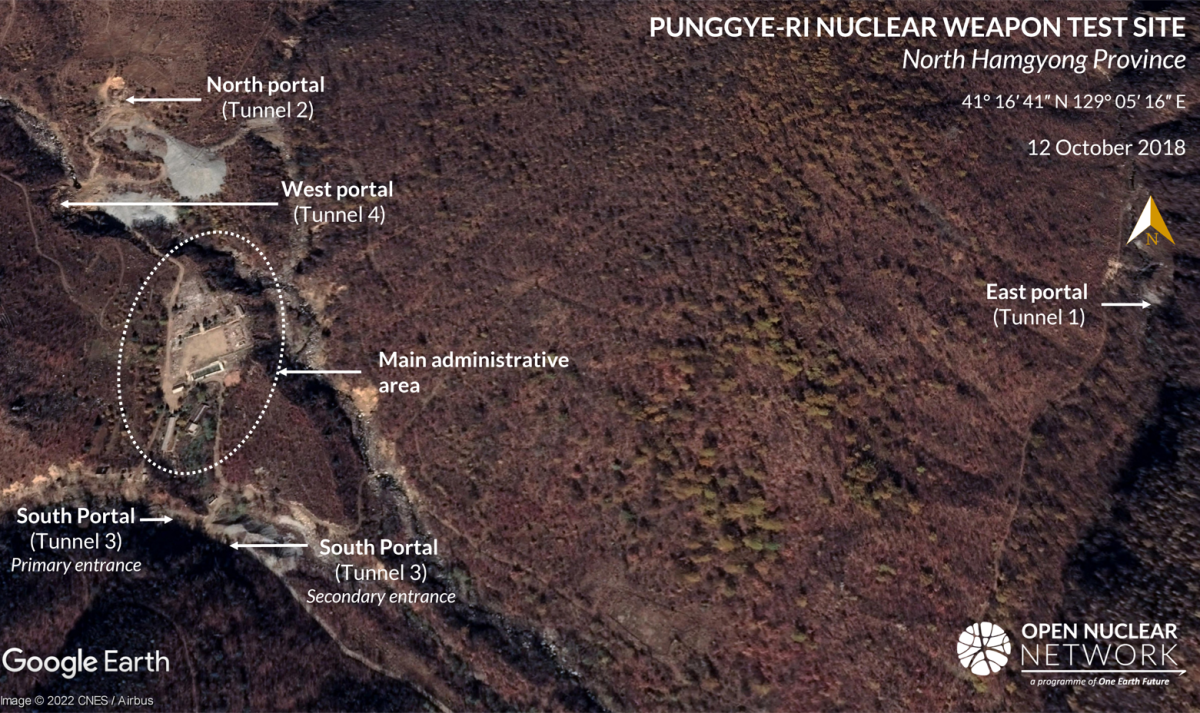
Figure 1. Overview of the Punggye-ri nuclear weapon test site. Image: Google Earth
The East Portal was used for the DPRK's first nuclear weapon test on 9 October 2006 and is believed to have been shut down after this test. [1] The North Portal was used for the nuclear tests on 25 May 2009, 12 February 2013, 6 January 2016, 9 September 2016 and 3 September 2017. [2] The West and South Portals have not been used for any nuclear weapon test to date.
At the South Portal, at least one primary tunnel entrance was known to exist, and another secondary tunnel entrance was also identified because of the previously observed excavation activities near the primary entrance. [3] Excavation activities at the South Portal ended in late 2013.
In April 2018, the Political Bureau of the Central Committee of the DPRK's Workers' Party of Korea (WPK) decided to suspend nuclear and ICBM testing as part of the DPRK's confidence building measures before the June 2018 Singapore Summit meeting between then-US President Donald J. Trump and Kim Jong Un. [4] Following this decision, in May 2018, the DPRK announced that it had demolished all of the portals, except for the East Portal which had already been shut down reportedly after the first nuclear weapon test in 2006. [5] It remains unclear whether the DPRK did completely demolish the tunnels or just the entrances to the tunnels.
Since then, the Punggye-ri nuclear test site remained almost inactive, with the presence of personnel and signs of their movement only occasionally visible on available satellite imagery.
On 12 June 2018, Trump and Kim issued a joint statement in which the two leaders agreed to strive to build "a lasting and stable peace on the Korean Peninsula." Kim agreed to commit the DPRK to "work toward complete denuclearization of the Korean Peninsula." [6] Thereafter, however, the DPRK-US negotiations stalled with regard to the implementation of these agreements.
During his speech at the WPK's Eighth Congress in January 2021, Kim Jong Un announced his decision to develop "nuclear technology to a higher level," make "nuclear weapons smaller and lighter for more tactical uses" and continue to advance "the production of super-sized nuclear warheads." [7] Kim indicated his intention to resume nuclear weapon testing in the near future.
In January 2022, the Political Bureau decided to reconsider "the trust-building measures" with the US and "to promptly examine the issue of restarting all temporarily-suspended activities." [8] It also indicated its intention to resume the testing of ICBMs and nuclear weapons. This decision was followed by the DPRK's launches of ICBMs in March 2022, demonstrating an end to its moratorium on ICBM tests. [9] In its announcement of the 24 March ICBM launch, DPRK media once again made an explicit reference to the development goals of "bolstering in a sustained way the nuclear war deterrence at the historic 8th Congress of the WPK." [10] Kim Jong Un also asserted the intention to develop "much more powerful strike means." [11]
ONN has observed, within the same time period between January and March 2022, new developments at the Punggye-ri nuclear test site, especially near the South Portal and the main administrative area, which suggests that the DPRK has reactivated, or is in the process of reactivating, these locations.
Observations of New Developments
Since December 2021, available satellite imagery has shown signs of increasing activities within this site, especially at the South Portal and the main administrative area. In the available satellite images, signs of excavation were visible close to the secondary entrance to the South Portal in March 2022, as well as indications of construction and renovation activities. Signs of increased vehicle traffic and movements of personnel were also visible near this portal.
Additionally, there have been recent signs of personnel movements and vehicle traffic near the North and West Portals. However, there are no signs of excavation activities near these two portals. No sign of any activities could be identified near the East Portal as of 24 March 2022.
Further, there is a support centre approximately 6.3 kilometres south of the main administrative area (hereafter referred to as the "southern support centre") where ongoing activities have been observed since 2018.
Main Administrative Area
Since December 2021, available satellite images have shown that activities had resumed at the main administrative area, including likely removal of snow and signs of vehicle traffic within and around this area (Figure 2).
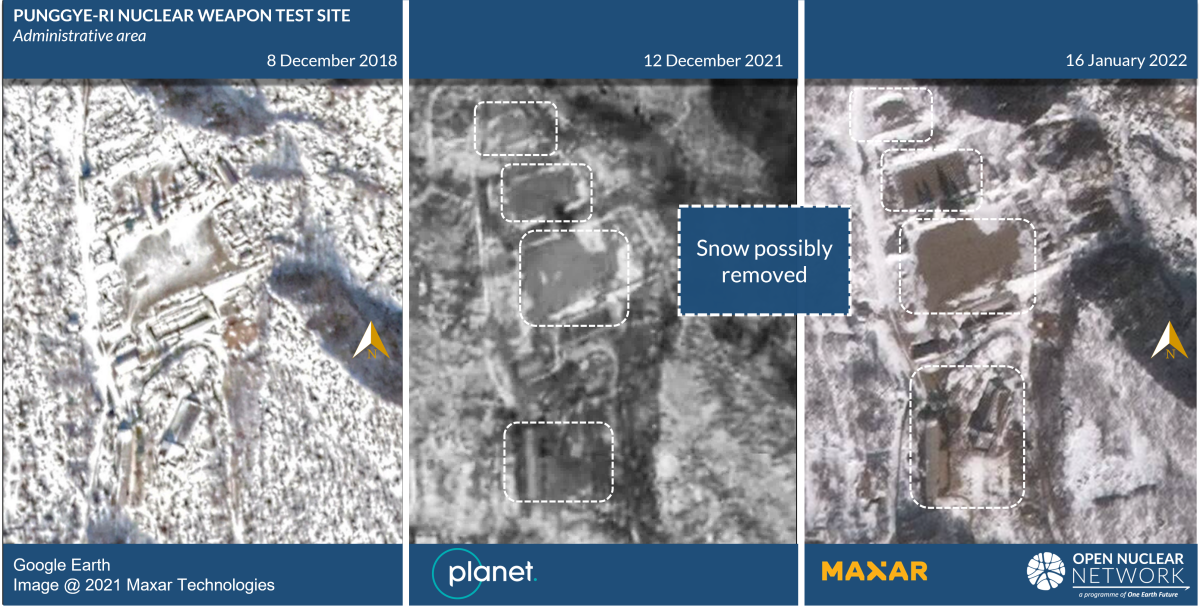
Figure 2. Likely removal of snow in the main administrative area in December 2021 and in January 2022. Image left: Google Earth; Image middle: © 2022 Planet Lab. All Rights Reserved. Reprinted by permission.; Image right: © 2022 Maxar Technologies. All Rights Reserved. Reprinted by permission
In February 2022, available satellite images showed signs of increased vehicle traffic along the roads between the main administrative area and the South Portal, especially its secondary entrance, indicating an increased level of activity within and near this area and portal (Figure 3).

Figure 3. Likely removal of snow along the road from between the main administrative area and the South Portal on 18 February 2022. Image: © 2022 Maxar Technologies. All Rights Reserved. Reprinted by permission
In March 2022, available satellite images also continued to show increased vehicle traffic within the main administrative area and along the roads between this area and the South Portal (Figure 4).
Possible log piles were also visible on the premises of a demolished building in this area (Figure 4). It should be noted that at the Punggye-ri nuclear test site, logs have previously been used not only for the construction of buildings but also for the excavation of the tunnels. [12] If the DPRK were to decide to restore the tunnel, nearby log piles or lumber would likely be visible.

Figure 4. Possible log piles and signs of vehicle traffic observed within the main administrative area on 23 March 2022. Image: © 2022 Maxar Technologies. All Rights Reserved. Reprinted by permission
South Portal
A satellite image from 4 March 2022 showed signs of construction and renovation activities near the South Portal, especially near its secondary entrance, including the construction of a new building and renovation of an old semi-destroyed building, as well as log piles visible near the secondary entrance (Figure 5).
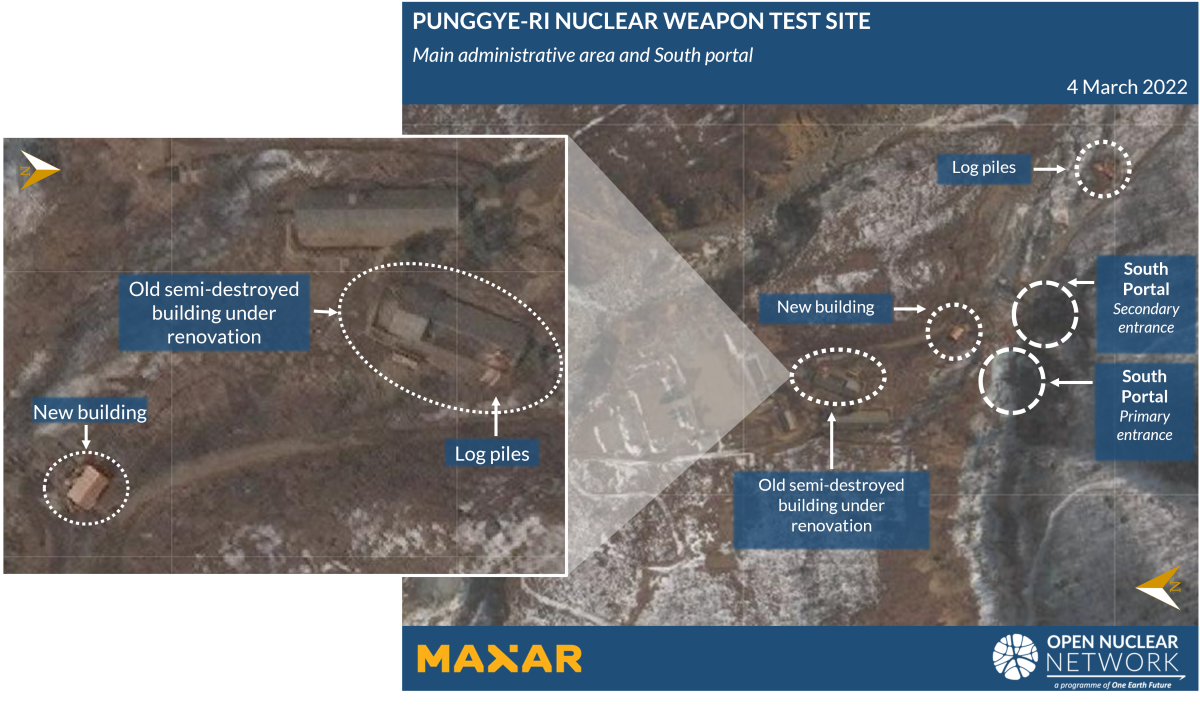
Figure 5. Construction and renovation activities near the secondary entrance to the South Portal as of 4 March 2022. Image: © 2022 Maxar Technologies. All Rights Reserved. Reprinted by permission
The same satellite image showed signs of increased vehicle traffic near the South Portal, especially its secondary entrance. The soil surface near the South Portal appeared to have been disturbed (Figure 6).

Figure 6. Area near the secondary entrance to the South Portal as of 4 March 2022. Image: © 2022 Maxar Technologies. All Rights Reserved. Reprinted by permission
Subsequently, satellite images from 16 and 23 March 2022 showed that the roof of the semi-destroyed building - located between the main administrative building and the South Portal - had been partially repaired (Figure 7). Also in the same satellite images, an object became clearly visible next to the new building near the secondary entrance to the South Portal; this appeared to be a triangular structure possibly covered by tarps (Figure 8).

Figure 7. Renovation of the roof of the semi-destroyed building near the South Portal as of 16 and 23 March 2022. Image: © 2022 Maxar Technologies. All Rights Reserved. Reprinted by permission

Figure 8. Newly visible object next to the new building near the South Portal as of 16 and 24 March 2022. Image: © 2022 Maxar Technologies. All Rights Reserved. Reprinted by permission
This new building and the newly visible object were located exactly where two previous buildings related to the excavation of the primary and secondary entrances to the South Portal used to exist until they were demolished in May 2018 (Figure 9). The new building and the newly visible object are likely to be used for any new excavation of the secondary entrance.

Figure 9. Satellite image from May 2013 showing the primary and secondary entrances to the South Portal, annotated with the locations of the new construction and renovation activities that were observed near these entrances on 4 March 2022. Image: Google Earth
On the satellite images from 23 and 24 March 2022, several signs of excavation activities were observed near the secondary entrance to the South Portal. First, a possible road became visible in the vicinity of the secondary entrance, which appeared to lead into the underside of a square structure on the mountain side - likely the secondary entrance or a possible new entrance to the South Portal (Figure 10). Signs of movements of vehicles or personnel were visible surrounding the square structure (Figure 10).
In addition, near the secondary entrance, there were at least two locations where soil surfaces were covered by brown coloured materials - probably soil piles or log piles, which is uniquely distinct from the surrounding snow-covered surfaces (Figure 10). It should be noted that the soil piles from the previous excavation of the South Portal have been accumulated around the same locations. The DPRK is likely to continue to dispose of soil piles from new excavation around these locations.
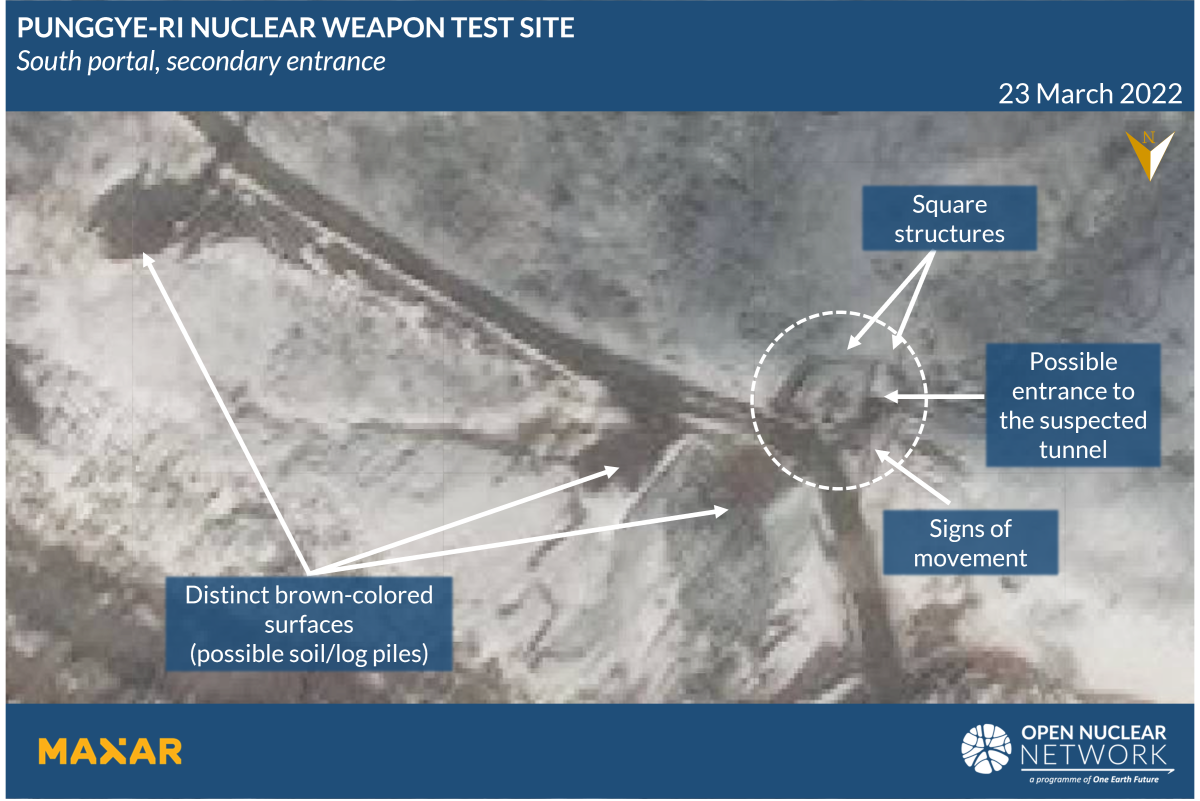
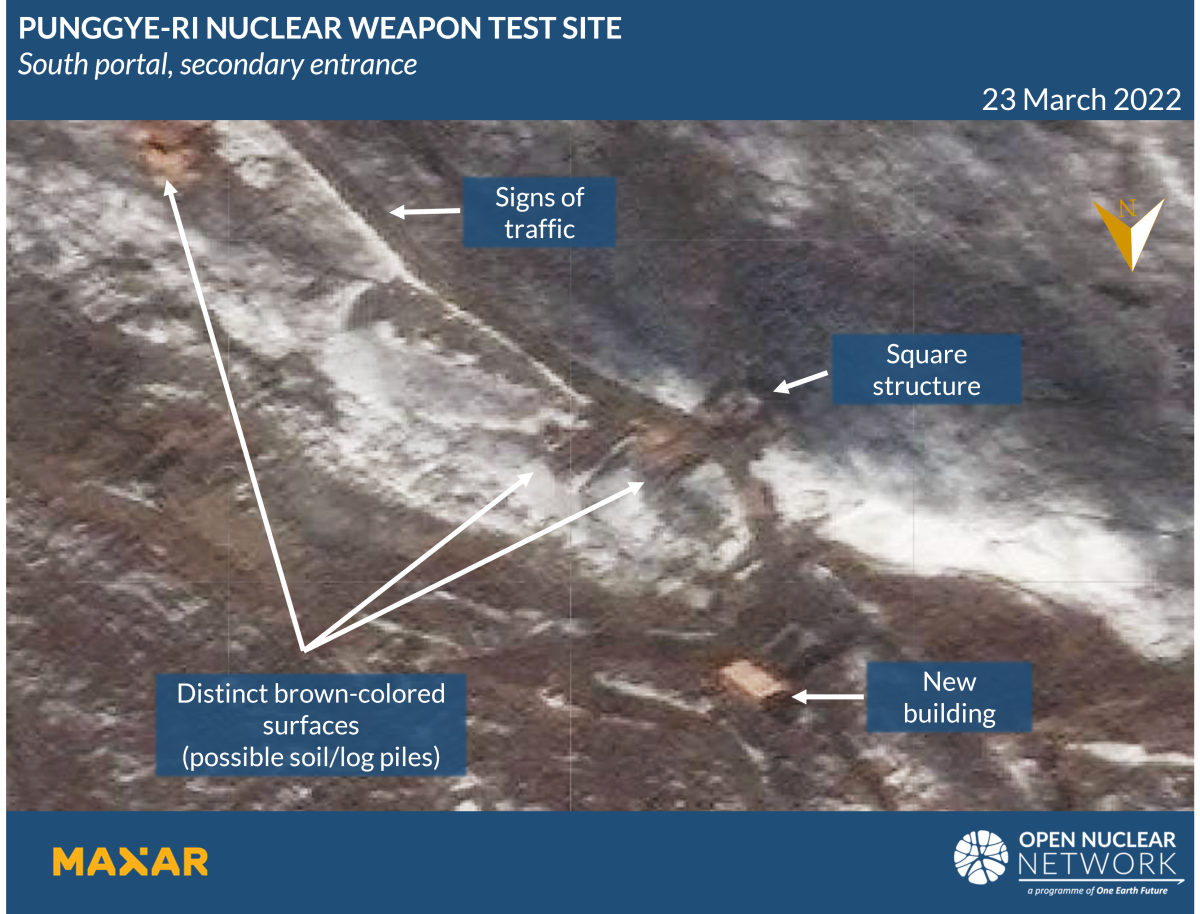
Figure 10. Satellite images from 23 and 24 March 2022 showing the square structures and distinct soil surfaces near the secondary entrance to the South Portal. Images: © 2022 Maxar Technologies. All Rights Reserved. Reprinted by permission
In 2018, the DPRK demolished the primary entrance to the South Portal; it is unclear how extensively the tunnel structure itself was damaged. While the secondary entrance appeared to have been closed long before the demolition of the primary entrance in 2018, there is no information available with respect to the status of the tunnel structure inside this entrance.
The South Portal is not known to have been used for any nuclear weapon test in the past. If the tunnel structure inside this portal was not damaged extensively in May 2018, it might be possible for the DPRK to rapidly restore access to the tunnel through the secondary entrance.
North and West Portals
The satellite images from 16 and 24 March 2022 showed signs of movements of personnel and vehicle traffic between the main administrative area and the North and West Portals, as indicated by the worn paths visible along the roads (Figures 11-12). Worn paths were also visible around the North and West Portals (Figure 12). No signs of excavation activities could be observed in these satellite images.
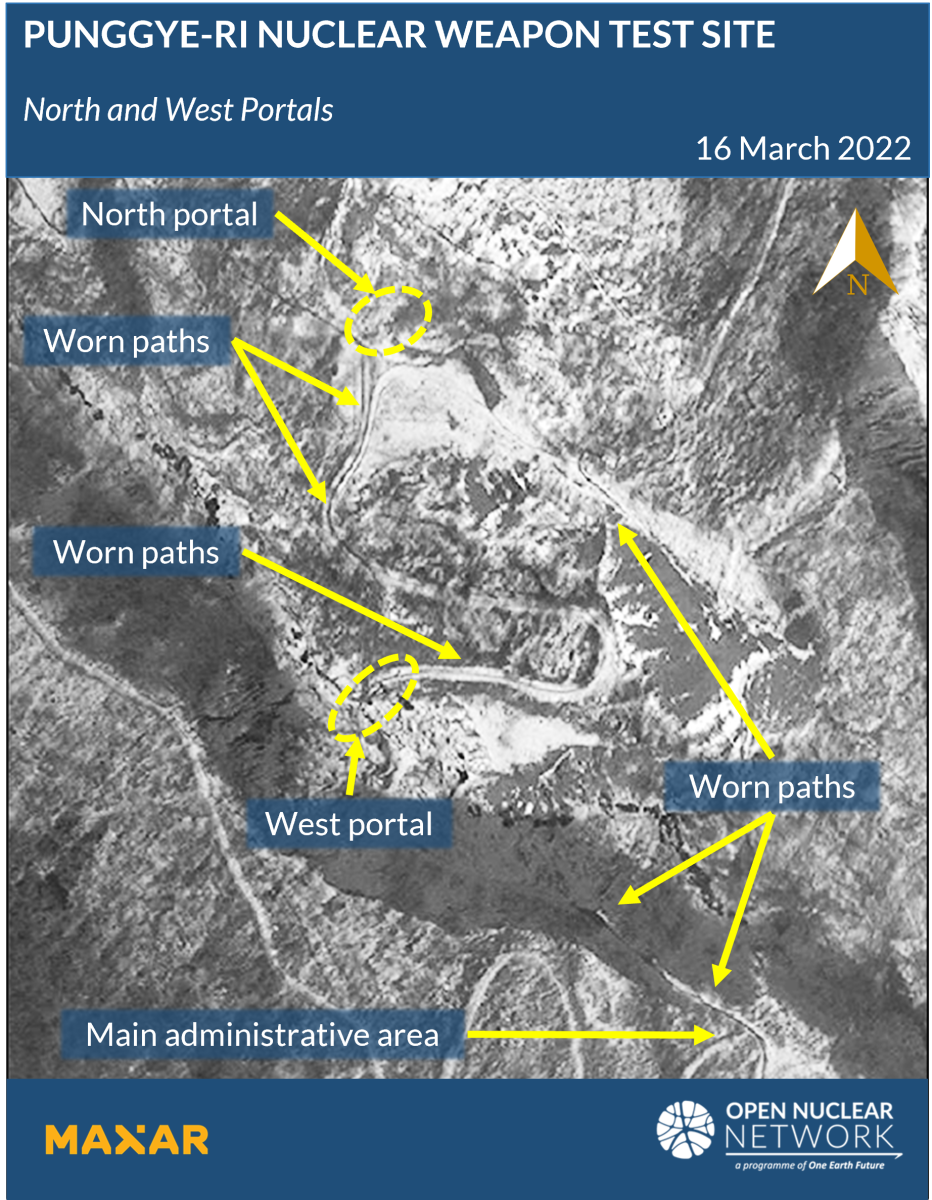
Figure 11. Satellite images from 16 March 2022 showing the North and West Portals and the roads between these portals and the main administrative area. Image: © 2022 Maxar Technologies. All Rights Reserved. Reprinted by permission
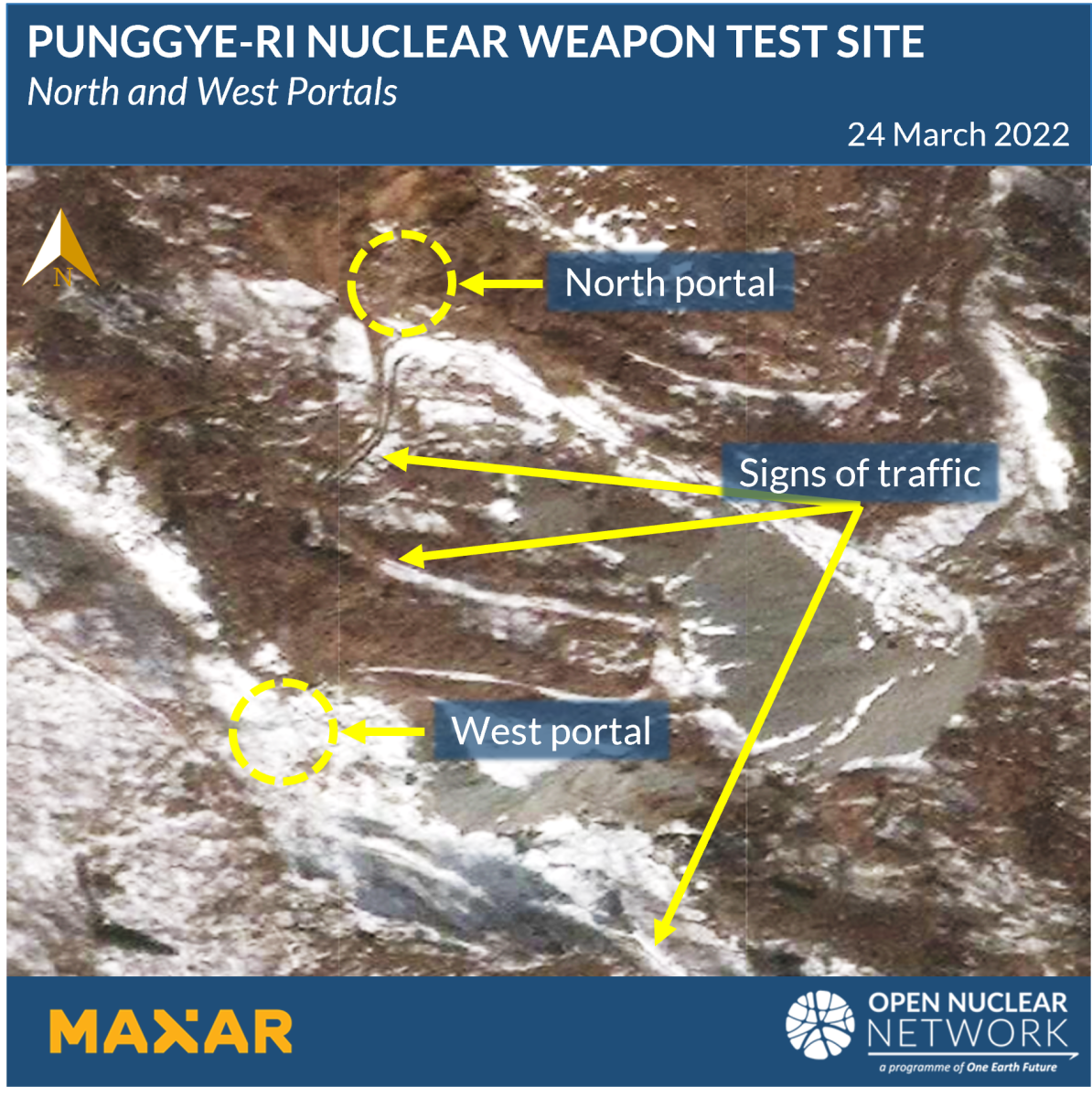
Figure 12. The satellite image from 24 March 2022 showing the North and West Portals. Image: © 2022 Maxar Technologies. All Rights Reserved. Reprinted by permission
East Portal
At the East Portal, no sign of activities could be observed in available satellite images as of March 2022 (Figure 13).
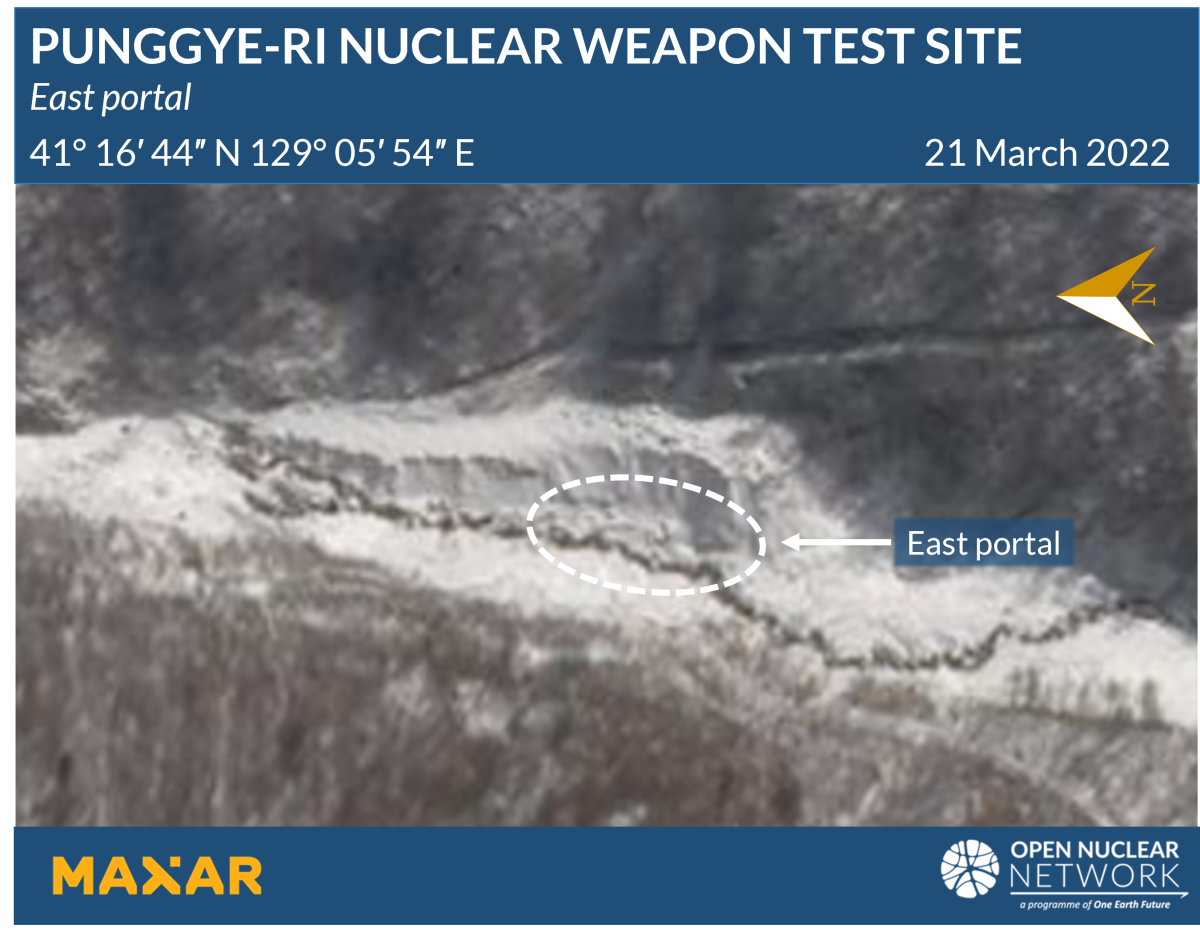
Figure 13. The satellite image from 21 March 2022 showing the East Portal. Image: © 2022 Maxar Technologies. All Rights Reserved. Reprinted by permission
Southern Support Area
The southern support area for the Punggye-ri nuclear test site is located approximately 6.3 kilometres south of the main administrative area. This area is known to consist of a command centre, a support section, security barracks and administration buildings. This area has been active consistently, even after the demolition of the tunnels in 2018, likely performing the required maintenance for the nuclear weapon test site. A satellite image from 24 March 2022 showed that snow had been cleared from all of these facilities, demonstrating that they have continued to operate (Figure 14).
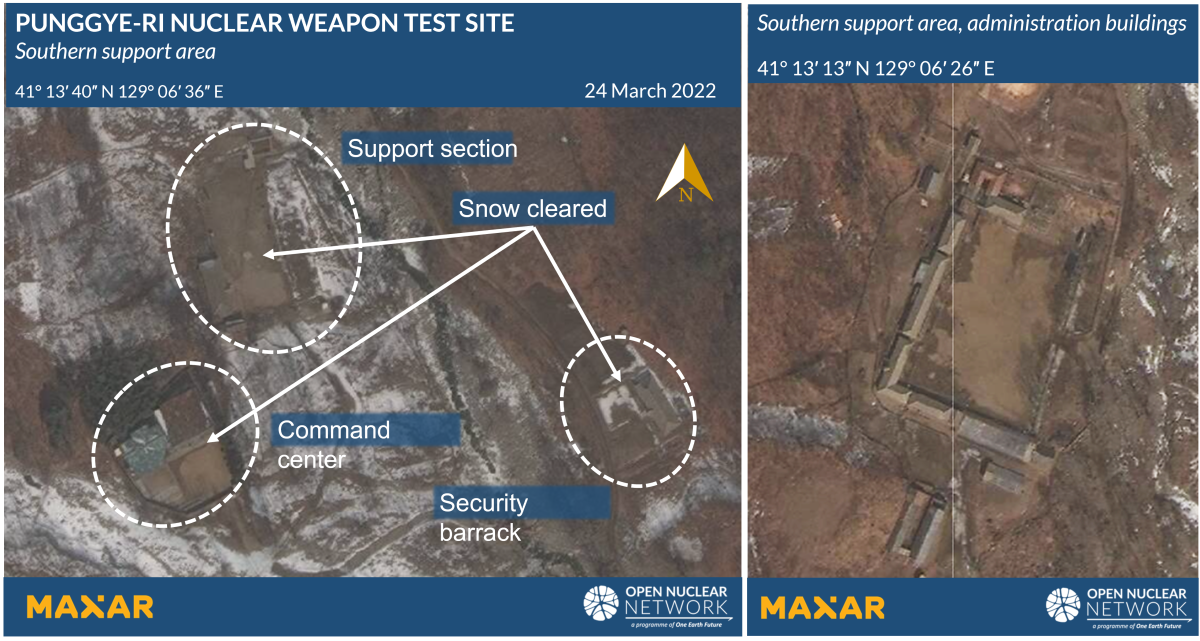
Figure 14. The satellite image from 24 March 2022 showing the Southern support area. Image: © 2022 Maxar Technologies. All Rights Reserved. Reprinted by permission
Implications
As of 27 March 2022, satellite imagery available to ONN indicates the following developments at the Punggye-ri nuclear test site since December 2021:
1. Main administrative area:
a. Increased vehicle traffic within the main administrative area and along the roads between this area and the South Portal; and
b. Piles of logs that could be used for the construction of building(s) or restoration of the demolished tunnels.
2. South Portal:
a. Excavation of the secondary entrance to the South Portal;
b. Construction and renovation activities near the South Portal; and
c. Increased vehicle traffic and movement of personnel near the South Portal in March 2022.
3. North and West Portals:
a. Movement of personnel and vehicle traffic near the North and West Portals, and between these two portals and the main administrative area; but
b. No sign of excavation as of 24 March 2022.
4. East Portal:
a. No sign of activities.
5. Southern support area
a. Ongoing activities within and around this area.
These developments clearly show that the DPRK has reactivated, or is in the process of reactivating, some parts of the Punggye-ri nuclear test site, especially the South Portal and the main administrative area. The DPRK has very likely already started its efforts to restore the secondary entrance to the South Portal or establish a new entrance nearby.
Reportedly, as of 27 March 2022, Republic of Korea (ROK) authorities assessed that the DPRK initially tried to restore an entrance to the South Portal, but then halted these activities, and instead started a new effort to make a "shortcut" to the South Portal by digging up "the side of the tunnel." In doing so, the ROK authorities reportedly assessed, it might become possible for the DPRK to restore this tunnel "within a month" and prepare for the seventh nuclear weapon test speedily. Analysis of available satellite imagery is consistent with this hypothesis, indicating that the DPRK's excavation efforts have likely started in order to restore the South Portal for use in an upcoming nuclear weapon test.
ONN will continue to monitor developments at the Punggye-ri nuclear test site.
[1] In May 2018, a deputy director of the DPRK's "nuclear research institute" briefed a group of journalists who visited the Punggye-ri nuclear test site to observe the demolition of the tunnels that the East Portal had been already shut down. Available satellite imagery has shown that the entrance to this portal
has been closed since no later than October 2009. According to 38 North, the East Portal was sealed and abandoned after the 2006 test reportedly due to radioactive contamination. See Will Ripley, Tim Schwarz and Paul Devitt, North Korea blows up tunnels at Punggye-ri nuclear test site, CNN, 25 May 2018, available at: https://edition.cnn.com/2018/05/24/asia/north-korea-nuclear-test-site-intl/index.html, and Frank V. Pabian, Joseph S. Bermudez Jr. and Jack Liu, More Potential Questions About the Punggye-ri Nuclear Test Site Destruction, 38 North, 8 June 2018, available at: https://www.38north.org/2018/06/punggye060818/
[2] Frank Pabian, The Punggye-ri Nuclear Test Site: A Test Tunnel Tutorial, 38 North, 23 May 2018, available at: https://www.38north.org/2018/05/punggyetunnel052318/
[3] Nick Hansen, Two New Tunnel Entrances Spotted at North Korea's Punggye Nuclear Test Site, 38 North, 23 October 2013, available at: https://www.38north.org/2013/10/punggye102313/, and The Punggye-ri Nuclear Test Site: A Test Tunnel Tutorial, 38 North, 23 May 2018, available at: https://www.38north.org/2018/05/punggyetunnel052318/
[4] 3rd Plenary Meeting of 7th C.C., WPK Held in Presence of Kim Jong Un, Korea Central News Agency, 21 April 2018
[5] Will Ripley, Tim Schwarz and Paul Devitt, North Korea blows up tunnels at Punggye-ri nuclear test site, CNN, 25 May 2018, available at: https://edition.cnn.com/2018/05/24/asia/north-korea-nuclear-test-site-intl/index.html
[6] Joint Statement of President Donald J. Trump of the United States of America and Chairman Kim Jong Un of the Democratic People's Republic of Korea at the Singapore Summit, White House, 12 June 2018, available at: https://trumpwhitehouse.archives.gov/briefings-statements/joint-statement-president-donald-j-trump-united-states-america-chairman-kim-jong-un-democratic-peoples-republic-korea-singapore-summit/
[7] Great Programme for Struggle Leading Korean-style Socialist Construction to Fresh Victory. On Report Made by Supreme Leader Kim Jong Unat Eighth Congress of WPK, KCNA, 9 January 2021, available at: http://kcna.kp/en/article/q/4bd89fa5293bdf0a82d3f4323d1636e2.kcmsf
[8] 6th Political Bureau Meeting of 8th C.C., WPK Held, Rodong Sinmun, 20 January 2022
[9] Tianran Xu, 24 March 2022 DPRK ICBM Test, Open Nuclear Network, 25 March 2025, available at: https://oneearthfuture.org/research-analysis/24-march-2022-dprk-icbm-test
[10] Striking Demonstration of Great Military Muscle of Juche Korea: Successful Test-Launch of New-Type ICBM, Respected Comrade Kim Jong Un Guides Test Launch of ICBM Hwasongpho-17, KCNA, 25 March 2022, available at: http://kcna.kp/en/article/q/031ef1d31382afc9098d5ae3f305d3a5.kcmsf
[11] Respected Comrade Kim Jong Un Has Photo Session with Those Who Contributed to Successful Test-Fire of Hwasongpho-17 Type, KCNA, 28 March 2022, available at: http://kcna.kp/en/article/q/ba9e9cc2cf8b6551ee2339dd07f559e7.kcmsf
[12] For example, see Destruction at North Korea's Nuclear Test Site: A Review in Photos, 38 North, 25 May 2018, available at: https://www.38north.org/2018/05/punggye052518/, and Update on Punggye-ri: Stepped Up Activity at West Portal, Drawdown at the South Portal, 38 North, 2 May 2014, available at: https://www.38north.org/2014/05/punggye050214/
[13] N. Korea carrying out construction at Punggye-ri nuclear test site: sources, Yonhap News Agency, 27 March 2022, available at: https://en.yna.co.kr/view/AEN20220327001200325?section=nk/nk
[14] N. Korea carrying out construction at Punggye-ri nuclear test site: sources, Yonhap News Agency, 27 March 2022, available at: https://en.yna.co.kr/view/AEN20220327001200325?section=nk/nk
